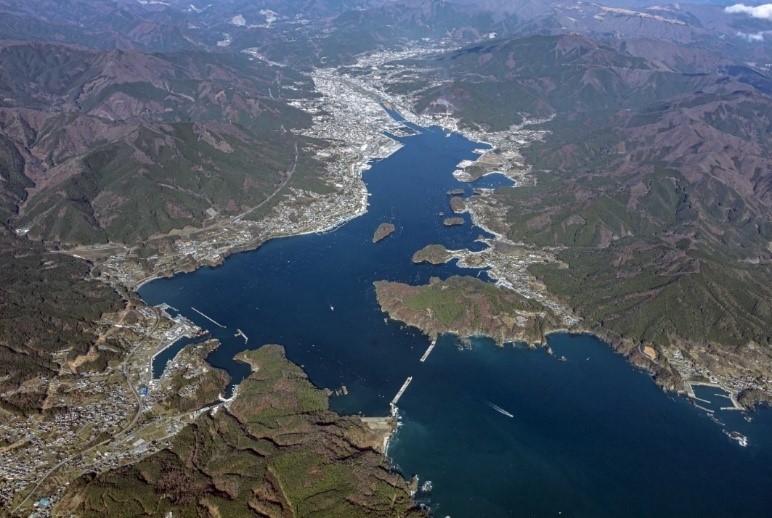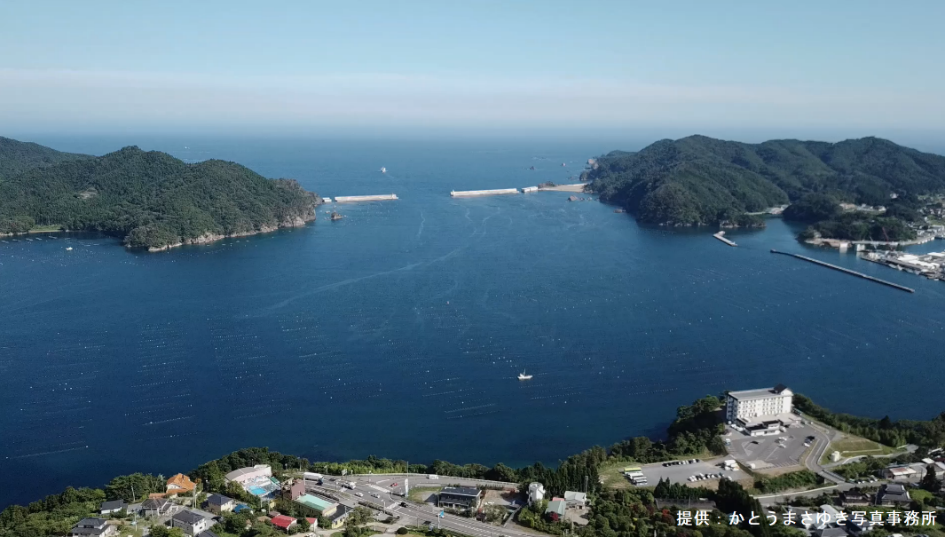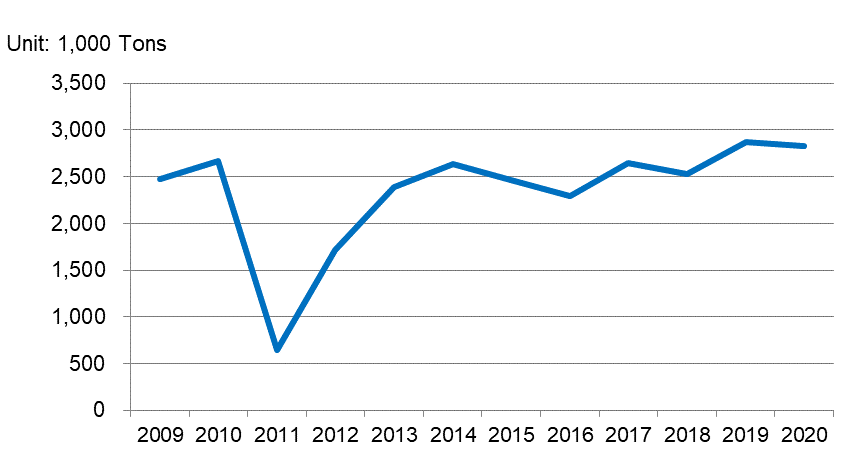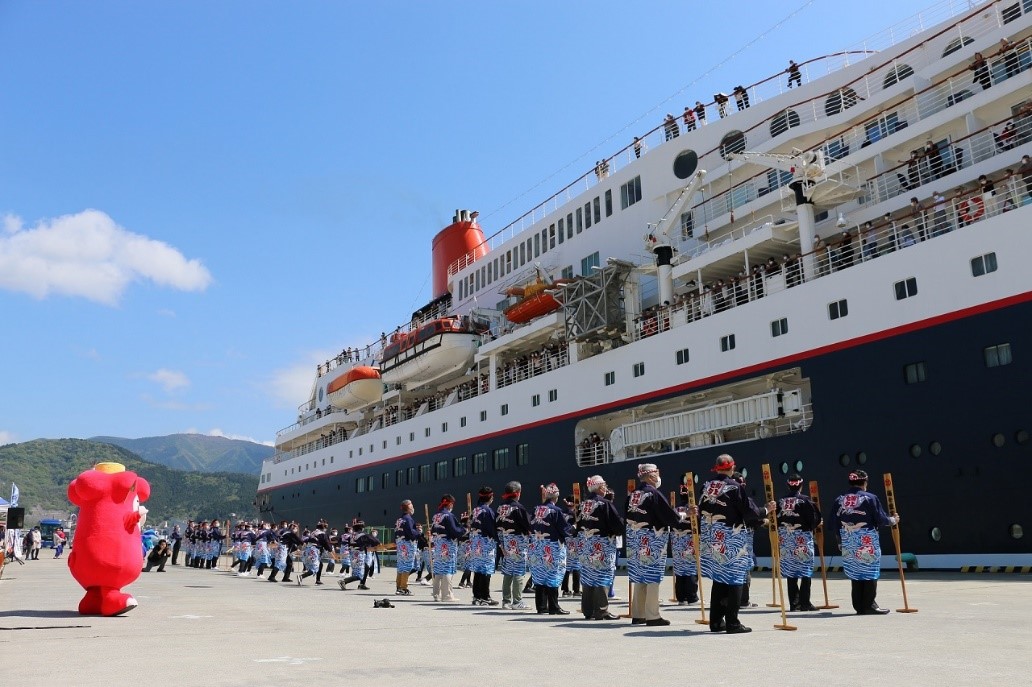Becoming a Logistics Hub for the ILC
Within the ILC Project plan, it is expected that cryomodules, one of the most important experimental equipment, in addition to cooling equipment and other devices necessary for the research facilities, will be sent from United States and Europe by sea.
In the “ILC Tohoku Master Plan,” released by the Tohoku ILC Promotion Council in 2018, it states that Ofunato Port is positioned to be one of the logistics hubs (unloading bays) for ILC construction materials and equipment sent by sea and are anticipated to play a key role in its realization. As such, we would like to take this time to explain the key features of Ofunato Port in this article.
The Journey of Ofunato Port
Iwate prefecture, Ofuanto city, the city where Ofunato Port is located, is a port city situated approximately an hour driving distance from the anticipated ILC construction site in the southern coastline of Iwate prefecture.
Ofunato Port is measured at, longest length of 6km and longest width of 2km, and the surrounding hills and deep bays peculiar to the Rias coast helped this natural port prosper significantly.
The importance of Ofunato Port was recognized in 1881 when the huge naval warship “Raiden” had made a port call here, attracting attention ever since.
At the mouth of Ofunato Bay, there is an enormous breakwater that is 244m long in the northern direction and 291m long in the southern direction and has 201m long opening.
The breakwater at the mouth of the bay was constructed after the 1960 Chilean Earthquake and Tsunami, and with a maximum depth of 38m, this was said to be the first deep-sea breakwater in Japan. Additionally, this breakwater ensures the wind and waves within the harbor to be extremely low, creating a well maintained quiet and calm bay.
Ofunato Port is also characterized by its multifaceted functions. A “commercial port” that handles the prefecture’s largest marine cargo, a “fishing port” managed in conjunction with the Ofunato Fish Market, boasting the largest pull of fish in the prefecture, and an “industrial port” that handles cement-related cargo.
 [Picture: Birds-eye-view of Ofunato Port]
[Picture: Birds-eye-view of Ofunato Port]
Recovery from the Great East Japan Earthquake and Tsunami
On March 11, 2011, Ofunato city and other eastern Japan areas facing the Pacific Ocean suffered an unprecedented disaster, resulting in the loss of many lives and properties.
In Ofunato Port, the breakwater at the mouth of the bay, which had played a major role in preventing tsunami disasters of the region for approx. 40 years since its completion in 1966, was completely destroyed. Additionally, the tsunami had caused port facilities and cargo handling machinery, owned by both public and private facilities, to be rendered unusable.
Restoration work of the breakwater was carried out from 2012 to 2017, one year after the Great East Japan Earthquake and Tsunami. The newly completed breakwater is now 11.3m above sea water, more than twice the height as it was before the disaster, and is expected to reduce tsunami damage going forward.

[Picture: Restored Ofunato Bay Mouth Breakwater]
The largest cargo volume handled in all of Iwate Prefecture
Sea freight handling volumes, which had fell due to the Great East Japan Earthquake and Tsunami, has increased each year since the disaster and have recovered to pre-disaster levels in recent years.
In FY2020, even during the global logistics turmoil caused by the pandemic, Ofunato Port had over 2.83 million tons of sea freight handling volume, which makes up over 50% of the total volume handled within all of Iwate prefecture.

[Graph: Sea Freight Handling Volume of Ofunato Port]
Sightseeing near Ofunato Port
Ofunato Port is home to a large number of fishes throughout the year thanks to the Sanriku Fishing Grounds and also thanks to the port’s perseverance to flourish as an aquaculture.
Depending on the season, visitors can enjoy a wide variety of fresh seafood such as abalone, oysters, scallops, seaweed, as well as squid, Pacific saury, salmon, and even tuna.
Additionally, Ofunato Port boasts the largest catch of Pacific saury in all of mainland Japan (AKA Honshu), and Ofunato’s specialty, the “Ofunato Sanma* Ramen” which use Pacific sauries as the main ingredient within the ramen is very popular.
*Sanma is the Japanese word for Pacific Saury
Last but not least, famous Japanese cruise ships such as “Asuka II” and “Nippon Maru” make a port call here. When cruise ships arrive, the city readies specialty seafood stands and celebrates with a sincere hospitality attraction unique to Ofunato featuring the local residents. This has been quite popular amongst the cruise ship passengers.

[Photo: Citizens welcoming the cruise ship].
We hope that Ofunato Port will play an active role as one of the major hubs for transporting ILC-related equipment in the future, and that it will become a memorable place for everyone who visits!
Japanese
【国際港湾都市 大船渡】ILCにおける物流拠点を目指して
ILC 計画では、重要な実験装置のクライオモジュールをはじめ、冷却設備など研究施設の設備に必要な機器類が、アメリカやヨーロッパから海上輸送されることが想定されています。
2018年に東北ILC推進協議会が公表した「ILC東北マスタープラン」においては、「大船渡港」が海上輸送されるILC建設資機材の荷揚げ湾(物流拠点の)一つに位置づけられており、ILC実現に向けて、大きな役割を担うことが期待されています。本記事では、「大船渡港」の特徴について説明します。
大船渡港のあゆみ
大船渡港がある岩手県大船渡市は、岩手県沿岸南部のILC建設予定地から車でおよそ1時間園内の距離にある港町です。
大船渡港は、リアス海岸特有の深い入り江と周囲を丘陵に囲まれた全長6㎞、最大幅は2㎞にも及ぶ天然の良港として栄えてきました。
1881年に「雷電」という巨大な軍艦が入港したことをきっかけに、港湾価値の大きいことが認められ、以後その重要性が注目されてきたと言われています。
大船渡港の湾口部には、北提が延長244m、南提が延長291m、開口部が201mにも及ぶ巨大な防波堤が設置されています。
この湾口防波堤は、1960年のチリ地震津波を契機に整備され、最大水深-38mにも及ぶ日本初の深海防波堤となっています。この湾口防波堤によって、港内は常に風波が極めて少なく、優れた静穏域が確保されています。
その他にも、大船渡港は、県内最大の海上貨物を取り扱う「商港」をはじめ、県内トップの水揚げを誇る大船渡市魚市場を有する「漁港」、セメント関連貨物等を取り扱う「工業港」など多面的な機能が備わっていることが特徴です。
[写真:上空から見た大船渡港]
東日本大震災からの復旧
2011年3月11日、当市をはじめ、太平洋に面する東日本一帯が未曾有の大災害に見舞われ、数多くの尊い人命と財産が失われました。
大船渡港では、1966年の完成から約40年間、地域の津波防災に大きな役割を果たしてきた湾口防波堤が全壊状態になり、民間施設を含む港湾施設や荷役機械も使用不可能になるなどの大きな被害を受けました。
湾口防波堤は、東日本大震災発生から1年後の2012年から2017年にかけて復旧工事が行われました。新たに完成した防波堤は、海面からの高さが、東日本大震災前のものと比べて2倍以上の11.3mになり、更なる津波被害の軽減効果が期待されています。
[写真:復旧した湾口防波堤]
岩手県内最大の取扱を誇る貨物量
東日本大震災の影響により落ち込んだ海上貨物取扱量は、年々増加しており、東日本大震災以前の水準まで回復しました。
新型コロナウイルスによる世界的物流の混乱があった、2020年度においても、282万8千トンあり、岩手県内全体の50%を超える取扱量となっています。
「図:大船渡湾の海上貸物取扱量」
大船渡港周辺観光
大船渡港では、世界三大漁場のひとつである三陸沖漁場から、1年を通してたくさんの魚が水揚げされ、大船渡湾内での養殖業も盛んです。
季節によって、あわび、かき、ほたて、わかめを始め、いか、さんま、鮭、鮪など、種類豊富で新鮮な海産物を堪能できます。
特に、「さんま」の漁獲量は本州一を誇り、さんまをラーメンの具材やスープに使った「大船渡さんまら~めん」が大船渡の名物です。
また、大船渡港には、クルーズ客船「飛鳥II」、「にっぽん丸」が入港しています。クルーズ客船の入港に際しては、大船渡のおいしい海産物や、大船渡ならではのアトラクションで歓迎し、市民挙げてのおもてなしは、乗船客から好評を博しています。
[写真:クルーズ船を歓迎する市民の方々]
今後、大船渡港が、ILC関連機器輸送のための拠点の1つとして活躍し、いらした皆さんにとって思い出深い場所になることを願っています。



